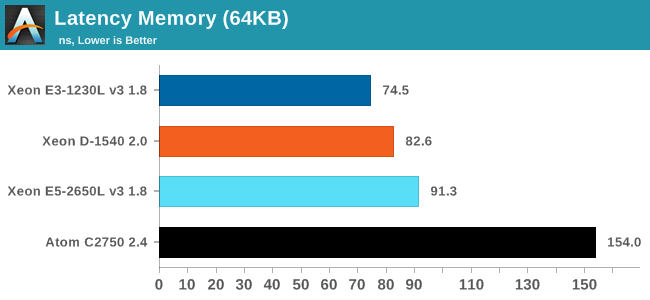The Intel Xeon D Review: Performance Per Watt Server SoC Champion?
by Johan De Gelas on June 23, 2015 8:35 AM EST- Posted in
- CPUs
- Intel
- Xeon-D
- Broadwell-DE
Memory Subsystem: Latency
To measure latency, we use the open source TinyMemBench benchmark. The source was compiled for x86 with gcc 4.8.2 and optimization was set to "-O2". The measurement is described well by the manual of TinyMemBench:
Average time is measured for random memory accesses in the buffers of different sizes. The larger the buffer, the more significant the relative contributions of TLB, L1/L2 cache misses, and DRAM accesses become. All the numbers represent extra time, which needs to be added to L1 cache latency (4 cycles).
We tested with dual random read, as we wanted to see how the memory system coped with multiple read requests. To keep the graph readable we limited ourselves to the CPUs that were different.
L3 caches have increased significantly the past years, but it is not all good news. The L3 cache of the Xeon E3 responds very quickly (about 10 ns or less than 30 cycles at 2.8 GHz) while the L3-cache of the new generation needs almost twice as much time to respond (about 20 ns or 50 cycles at 2.6 GHz). Larger L3 caches are not always a blessing and can result in a hit to latency - there are applications that have a relatively small part of cacheable data/instructions such as search engines and HPC application that work on huge amounts of data.
It gets worse for the "large L3 cache" models when we look at latency of accessing memory (measured at 64 MB):

The higher L3-cache latency makes memory accesses more costly in terms of latency for the Xeon E5. Despite having access to DDR4-2133 DIMMs, the Xeon E5-2650L accesses memory slower than the Xeon E3-1230L. It is also a major weakness of the Atom C2750 which has much less sophisticated memory controller/prefetching.











90 Comments
View All Comments
zodiacfml - Tuesday, June 23, 2015 - link
this is the reason why Intel focuses on mobile, it benefits their server cpus too.the 14nm process is the one to thank for these massive improvements. Samsung also has 14nm and the S6 Exynos is in similar achievement
Refuge - Tuesday, June 23, 2015 - link
I disagree, the Exynos is no where close to a similar achievement.Granted it is doing better than Qualcomm's equivalent at the moment.
But I'm also faster than a fat man with a broken leg running on a hot and humid day.
zodiacfml - Tuesday, June 23, 2015 - link
Still, these 14nm SoCs are the best in their class as they pack more cores while using less power.LukaP - Thursday, June 25, 2015 - link
Just a note, Samsung's (and TSMC's 16nm FF(+) process isnt really 16nm entirely. The interconnects are still 28nm making it not nearly as dense as intel's 14nm, as well as being more leaky. IIRC their density and leakage can be compared to intels 22nm TriGate in the times of Ivy Bridgenils_ - Tuesday, June 23, 2015 - link
Few questions:1. Why did you disable x2apic?
2. Did the Large Page allocation in the Java Benchmark actually work? It can be a bit tricky some times and then falls back to 4KiB pages
3. What were the JVM settings for elasticsearch?
JohanAnandtech - Thursday, June 25, 2015 - link
1. Was out of the box disabled. I have to admit I did not check that option. Performance impact should be neglible though.2. I have no monitored that, but there was a performance impact if we disabled it.
3. ES_heap_size = 20 G; otherwise standard ES settings
Daniel Egger - Tuesday, June 23, 2015 - link
Wow, that is still quite pricey here. For the price of the SuperMicro tower you can actually get a 1U 2S Xeon E5 system with one socket equipped and some memory. I'd really love to replace my home server (running on Core i5 rather than Xeon E3 for efficiency reasons, those C chipset suck balls) with one of those systems if they can make them efficient and quiet.hifiaudio2 - Tuesday, June 23, 2015 - link
Two questions:1. How does the Xeon D compare to the c2700 series for a home NAS that will also serve as an Emby server and HDHR DVR (when that software is available). Could be one or two 1080p transcodes going on at the same time at most. Usually no transcoding if I am using Kodi or something that can natively play back the file, but for remote viewing or random uses over the network, some transcoding by Emby could be required -- if you are not familiar with Emby think of the same thing using Plex. So would the extra power of the Xeon D be of use to me, or is the 8 core c2750 plenty for the aforementioned use case?
2. If I do go with this unit, which dimms specifically does it use? The Supermicro c2750 board takes laptop style dimms. What does this take?
JohanAnandtech - Tuesday, June 23, 2015 - link
I can answer 2: see the picture here: http://www.anandtech.com/show/9185/intel-xeon-d-re... RDIMMs or UDIMMS (= basically "normal" DDR-4) will do.hifiaudio2 - Tuesday, June 23, 2015 - link
Thanks.. So this ram:?http://www.amazon.com/Crucial-PC4-2133-Registered-...
And what is the SR x4 / DR x8 difference in the two choices for the 8gb sticks?